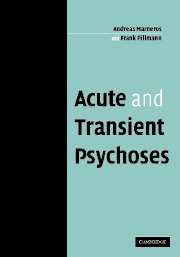Book contents
- Frontmatter
- Contents
- Preface
- Acknowledgements
- Part I History and concepts
- Part II Studies and findings
- 3 Studies on brief and acute psychoses
- 4 Frequency and sociobiographic characteristics of acute and transient psychotic disorders (ATPD) and brief psychoses (BP)
- 5 The clinical features of the acute episode
- 6 Treatment
- 7 The longitudinal course
- 8 The long-term outcome
- 9 Suicidal behaviour
- 10 Comorbidity and somatic findings
- Part III Issues of nosology
- References
- Index
4 - Frequency and sociobiographic characteristics of acute and transient psychotic disorders (ATPD) and brief psychoses (BP)
from Part II - Studies and findings
Published online by Cambridge University Press: 07 August 2009
- Frontmatter
- Contents
- Preface
- Acknowledgements
- Part I History and concepts
- Part II Studies and findings
- 3 Studies on brief and acute psychoses
- 4 Frequency and sociobiographic characteristics of acute and transient psychotic disorders (ATPD) and brief psychoses (BP)
- 5 The clinical features of the acute episode
- 6 Treatment
- 7 The longitudinal course
- 8 The long-term outcome
- 9 Suicidal behaviour
- 10 Comorbidity and somatic findings
- Part III Issues of nosology
- References
- Index
Summary
The frequency of ATPD
As already pointed out, there are virtually no sound epidemiological studies regarding the frequency of ATPD or BP. Susser and co-workers (1994), in their re-analysis of the DOSMED data, determined the annual incidence per 10 000 people of Non-affective Acute Remitting Psychosis (NARP) to be 0.486 for males and 0.878 for females in the developing country setting and 0.040 for males and 0.104 for females in the industrialised country setting. This compared to an annual incidence of ICD-9 schizophrenia (NARP excluded) of 1.328 for males and 1.089 for females in the developing country setting and 1.190 for males and 0.880 for females in the industrialised country setting. These data cannot be extended easily to ATPD and BP since definitions differ. The ten-fold higher incidence of NARP in the developing countries, however, corroborates the long-held impression that Brief and Acute Psychoses are much more frequent in developing than in industrialised countries.
Compared with epidemiological incidence data, it is much more feasible to determine the frequency of Brief and Acute Psychoses as the proportion of inpatients with broad definition psychotic disorders in a particular institution. Such data are available for NARP and for DSM-IV BP in the Suffolk County Mental Health project. In an analysis of 221 first-episode patients with DSM-III-R affective or non-affective psychoses including 117 cases of non-affective psychoses, Susser and co-workers (1995a) identified 7 patients with Acute Brief Psychoses (synonymous with Susser's definition of NARP as discussed above).
- Type
- Chapter
- Information
- Acute and Transient Psychoses , pp. 71 - 102Publisher: Cambridge University PressPrint publication year: 2004

